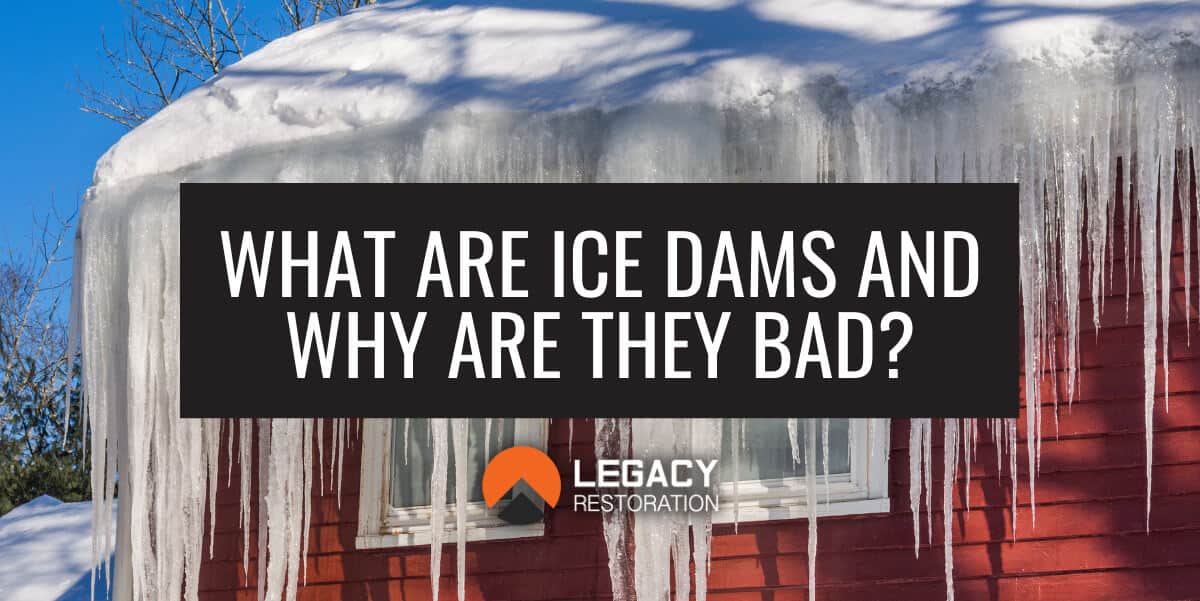Ice dams: two words that can make any homeowner shudder in winter! If you live in an area that experiences a harsh cold season, you’ll know all about ice dams, including how stressful it can be to resolve. Ice dams naturally affect those living up north. If that’s you, you’ll want to keep reading to find out precisely what ice dams are, how they form, and how you can better protect your home from leaks, roof damage, and unwanted expenses.
What Are Ice Dams?
An ice dam is a large block of ice that forms on the lower part of your roof. Changing temperatures contribute to snowmelt. After melting snow falls from the roof, it eventually comes into contact with the deck over the eaves, which don’t get heat from your attic as your roof does. Generally, this is where ice begins to form. This ice causes a blockage, preventing other water and melted snow from falling off the roof. The result is a “dam,” a pool of water with nowhere to go. As the ice dam grows, it forces this pool of water, or reservoir, back up the roof and under the shingles. As you may know, shingles shed water down, not up!
As the melted snow and ice work their way up under the shingles, the attic becomes flooded and eventually causes damage to its ceilings and walls. Ice dams can cause extensive damage to your home and its contents if they go unseen.
What Causes Ice Dams?
Understanding what causes a problem is often half the problem solved! The same is certainly the case for ice dams. The fact is that there isn’t just one cause. However, there are some more common than others. Here are the most common reasons why you might be experiencing ice damming.
Insufficient Insulation
For snow to melt from the outer layer and evaporate or run off, your roof should ideally be at the same temperature as the air outside. Older houses are often poorly insulated, which causes heat from the inside to rise into the attic and through the roof. This warms the roof deck and subsequently melts the snow. As it trickles down to the overhang, it re-freezes as this part of the roof isn’t heated by the escaping warm air.
Ventilation Issues
Your attic warms up so much because of poor ventilation. Properly ventilated attics can draw cold air from the outside, expelling warm air, which cools your roof.
Inadequate Maintenance
Homeowners may not be as vigilant as necessary to help prevent ice dams from forming. This is understandable! We all know how hectic life can be. However, there are two areas you may want to consider to prevent ice from forming.
- Installing ice shields around the edges of your roof and adopting a roof de-icing system.
- Clean foliage and other debris from your gutters before the season’s first snow. This will help prevent ice from building up in your gutters, further causing that blockage.
What Are The Negative Effects of Roof Dams?
So far, we have given you the most crucial information regarding ice dams, such as what they are, how they form, and what causes them. Now, let’s explain the adverse effects they can have on your home.
Exterior Damage
Damage to Shingles: pooled water being forced back up and under the shingles will cause them to loosen.
Damage to Gutters: the sheer weight of the ice on your gutters can cause them to wither.
Interior Damage
Attic: Once water seeps into your attic from the loose shingles, there is no end to the damage that can be caused. Once your insulation gets ruined, your R rating will decrease.
Ceilings & Walls: After making its way through your attic, water will run down through your ceilings, causing extensive damage to your whole home.
Home Content: you could have guessed it, but the contents of your house are at risk of becoming completely ruined once the water reaches the interior of your home.
How Can You Check For Damage From an Ice Dam?
Ice dam damage might not be as obvious as you think. Homeowners may even admire the hanging icicles for their beauty without understanding the extent of damage they can cause! If you are concerned about ice damming:
Check Your Attic: get into your attic and search around for any signs of leaking, droplets of water, or staining will give you an indication of the areas for concern.
Check Your Interiors: Inspect your home for signs of leaking and discolored areas of your ceilings. Note any signs of previous leaks and check your roof at the same spot to ensure no shingles or gutter damage.
Check Your Chimney: check for any ice forming at the base of the chimney. Check the flashing. Damaged flashing is one of the main reasons for chimney leaks because it can lead to moisture getting into the masonry system.
If you are still trying to figure out how to check for ice dam damage, our team of expert Roofers would happily arrange an inspection.
Does Homeowner Insurance Cover Ice Dam Damage?
Although many insurance providers cover ice dam damage, it is always a good idea to call them to check the extent of your coverage. Safeguarding not only your home but your family is the most important thing. Finding a comprehensive insurance plan that covers weather damage, such as ice damming, is vital, especially if you live in a colder climate.
Your Next Steps
There you have it; your homeowner’s guide to ice dams. We hope you feel equipped with the knowledge you need to survive another winter.
Did you know that Legacy Restoration has a team of roofing experts providing customers with elite craftsmanship and top-of-the-line materials at competitive prices? You can find more information about our residential roofing services here.

